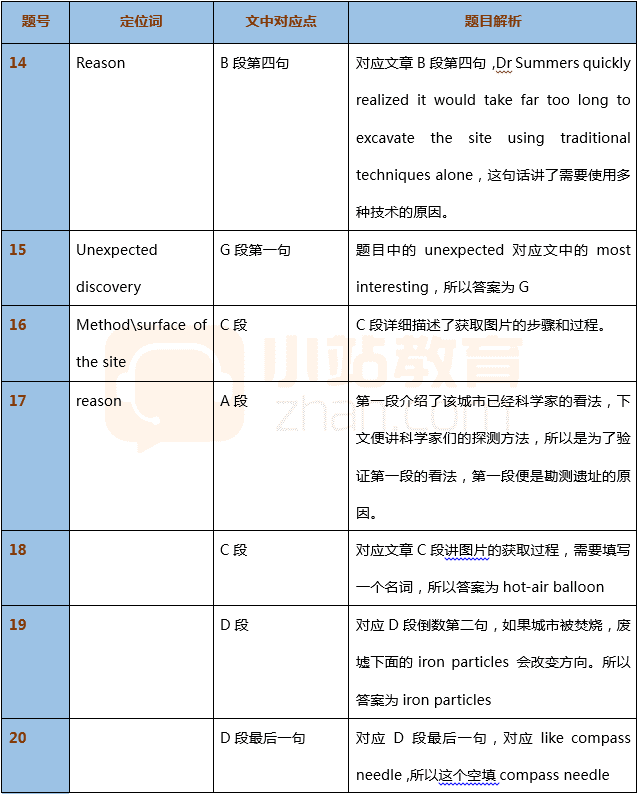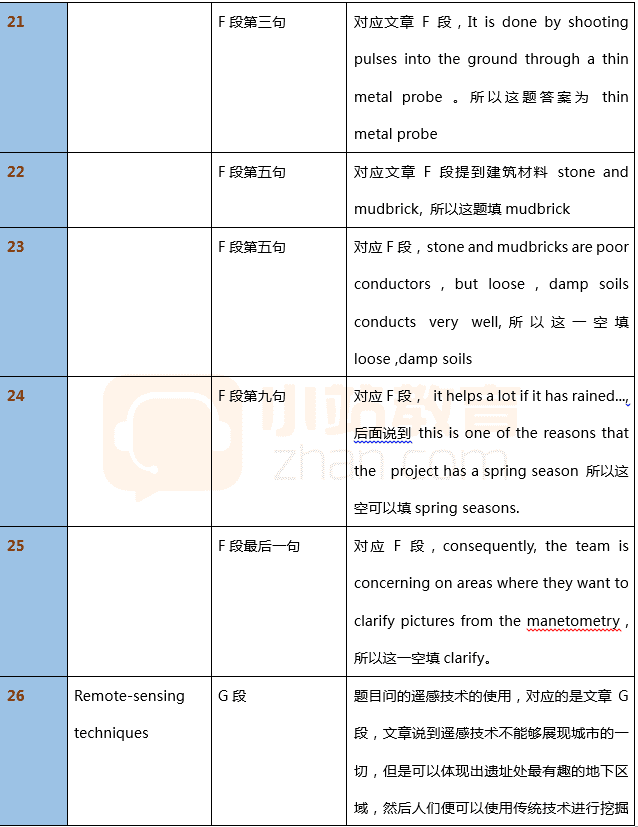雅思阅读解题技巧之选择题作题技巧
懂得雅思阅读技巧,做题会事半功倍哦。今天小编给大家带来了雅思阅读解题技巧之选择题作题技巧,希望能够帮助到大家,下面小编就和大家分享,来欣赏一下吧。
雅思阅读解题技巧丨Multiple Choice题型
1. 题型要求
这是一个传统题型,大家都很熟悉。但就是这种大家都熟悉的题型,IELTS考试也要弄出新花样。其它考试中,如四级、六级、TOEFL,只有四选一一种形式。IELTS考试的选择题分为四选一和多选多多两种。
四选一,选项肯定是四个。即要求从A、B、C、D四项中选择一个最符合题意的选项。多选多,选项肯定是五个或五个以上,而正确答案的数目肯定在两个以上。哪个更难呢?很多同学会好不犹豫地说是多选多。实际上,多选多很容易,是一种简单题型。它具有以下几个特点:
(1)正确答案的数目是已知的。在题目的要求中会告诉你要选出几个选项。题目要求中常WHICH FOUR, WHICH THREE 等字样。
(2)答案在原文中是集中出现的,对应原文中的例举。找着一个答案,其余几个就在它的前后不远处。
我们举一个中文阅读的例子来说明。文章如下:
帕金森症是一种顽症。它是由大脑中缺乏一种叫多巴胺的化学物质引起的。(后面删减100字)很多名人深受其苦。比如,我们的改革的总设计师、拳王阿里、以故数学家陈景润等等。(后面删减100字)
题目是:以下哪三个人得过帕金森症?
A. 邓小平B. 里根C. 拳王阿里D. 布什E. 陈景润 答案:ACE
四选一在考试中,一般比较难。它的特点是:四个选项,哪个都像。好像在原文中都提到了,但又都和原文的叙述不太一样。很容易选错。选择题和问答题的区别在于:问答题要求你自己从原文中找答案。而选择题给你四个选项,让你选择,在给你提示的同时,也给了你一个陷阱。有些选择题,如果改为回答题,你可能能够做对,但给了你四个选项,反而选错了。
考试中,四选一,A类和G类一般都是每次必考,考一组,共3题左右。多选多,不是每次必考。
2. 解题步骤
(1)找出题干中的关键词,最好先定位到原文中的一个段落。
将题干中的关键词与原文各段落的小标题或每段话的第一句相对照。有些题目能先定位到原文中的一个段落,着必将大大加快解题时间,并提高准确率。但并不是每个题目都能先定位到原文中的一个段落的。
如果题目中的关键词难以确定答案的位置,选项中的关键词也可以作为定位的参考依据。
(2)从头到尾快速阅读该段落,根据题干中的其他关键词及选项确定正确答案。正确选项常常是原文相关词句的改写。确定一个段落后,答案在该段落中有的具体位置是未知的。所以,需要从头到尾快速阅读该段落,确定正确答案。短问答的答案常常是原文原词,而选择题的答案常常是原文相关词句的改写。
(3)有些题目比较简单,可以直接选择。对于难题,可以用排除法确定正确答案。
有些题目比较简单,从原文很快找到对应答案。这时可以直接选择不必看其它选项。这样既可以节省时间,同时也避免受干扰选项的误导。有些题目比较难,看每个选项都有点像,但又都不太象。这时,可以用排除法,先排除掉肯定不对的选项,然后在剩下的选项中再做出选择。通常,有两个选项必有好排除,另外两个有一定的难度。请参见本题型的注意事项部分,其中分析了干扰选项的特点。
(4)要注意顺序性,即题目的顺序和原文的顺序基本一致。
题目是有顺序性的。第一题的答案应在文章的前部,第二题的答案应在第一题的答案之后。这个规律也有助于同学们确定答案的位置。
雅思阅读机经真题解析-The Lost City
Thanks to modern remote-sensing techniques, a ruined city in Turkey is slowly revealing itself as one of the greatest and most mysterious cities of the ancient world. Sally Palmer uncovers more.
A
The low granite mountain, known as Kerkencs Dag, juts from the northern edge of the C'appadocian plain in Turkey. Sprawled over the mountainside are the rums of an enormous city, contained by crumbling defensive walls seven kilometers long. Many respected archaeologists believe these are the remains of the fabled city of Plena, the sixth-century BC stronghold of the Mcdes that the Greek historian Herodotus described in his famous work The Histories. The short-lived city came under Median control and only fifty years later was sacked, burned and its strong stone walls destroyed.
B
British archeologist Dr Geoffrey Summer has spent ten years studying the site. Excavating the ruins is a challenge because of the vast area they cover. The 7 km perimeter walls run around a site covering 271 hectares. Dr Summers quickly realised it would take far too long to excavate the site using traditional techniques alone. So he decided to use modem technology as well to map the entire site, both above and beneath the surface, to locate the most interesting areas and priorities to start digging.
C
In 1993. Dr Summers hired a special hand held balloon with a remote-controlled camera attached. He walked over the entire site holding the balloon and taking photos. Then one afternoon, he rented a hot-air balloon and floated over the site, taking yet more pictures By the end of the 1994 season. Dr Summers and his team had a jigsaw of aerial photographs of the whole site. The next stage was to use remote sensing, which would let them work out what lay below the intriguing outlines and ruined walls. "Archaeology is a discipline that lends itself very well to remote sensing because it revolves around space," says Scott Branting, an associated director of the project, lie started working with Dr Summers in 1995.
D
The project used two remote sensing techniques. The first is magnetometry which works on the principle thai magnetic fields al the surface of the Earth are influenced by what it buried beneath. It measures localised variations in the direction and intensity of this magnetic field. "The Earth's magnetic field can vary from place to place, depending on what happened there in the past." says Branting. "if something containing iron oxide was heavily burnt, by natural or human actions, the iron particles in it can be permanently reoriented, like a compass needle, to align with the Earth's magnetic field present at that point in time and space." The magnetometer detects differences in the orientations and intensities of these iron particles from the present-day magnetic field and uses them to produce an image of what lies below ground.
E
Kerkenes Dag lends itself particularly well to magnetometry because it was all burnt at once in a savage fire. In places the heat was sufficient to turn sandstone to glass and to melt granite. The fire was so hot that there were strong magnetic signatures set to the Earth's magnetic field from the time - around 547 BC - resulting in extremely clear pictures. Furthermore, the city was never rebuilt, "if you have multiple layers confusing picture, because you have different walls from different periods giving signatures that all go in different directions," says Branting. "We only have one going down about 1.5 meters, so we can get a good picture of this fairly short-lived city”.
F
The other main sub-surface mapping technique, which is still being used at the site, is resistivity. This technique measures the way electrical pulses arc conducted through sub- surface soil. It's done by shooting pulses into the ground through a thin metal probe. Different materials have different electrical conductivity. For example, stone and mudbrick arc poor conductors, but looser, damp soil conducts very well. By walking around the site and taking about four readings per metre, it is possible to get a detailed idea of what is where beneath the surface. The teams then build up pictures of walls, hearths and other remains. "It helps a lot if it has rained, because the electrical pulse can get through more easily," says Branting. "Then if something is more resistant, it really shows up." This is one of the reasons that the project has a spring season, when most of the resistivity work is done. Unfortunately testing resistivity is a lot slower than magnetometry. "If we did (r the whole site it would take about 100 years," says Branting. Consequently, the team is concentrating on areas where they want to clarify pictures from the magnetometry.
G
Remote sensing does not reveal everything about Kerkenes Dag, but it shows the most interesting sub-surface areas of the site. The archaeologists can then excavate these using traditional techniques. One surprise came when they dug out one of the fates in the defensive walls. "Our observations in early seasons led us to assume that wall, such as would be found at most other cities in the Ancient Near East," says Dr Summers. "When we started to excavate we were staggered to discover that the walls were made entirely from stone and that the gate would have stood at least ten metres high. After ten years of study, Pteria is gradually giving up its secrets."
Question 14-18
Reading Passage2 has seven paragraphs, A-G.
Which paragraph contains the following information?
Write the correct letter, A-G, in boxes 14-17 on your answer sheet.
14. The reason why various investigative methods are introduced.
15. An example of an unexpected discovery.
16. The methods to surveyed the surface of the site from above.
17. The reason why experts want to study the site.
Question 18-25
Summary
Complete the following summary of the paragraphs of Reading Passage, using no more than THREE words from the Reading Passage for each answer. Write your answers in boxes 18-25 on your answer sheet.
Exploring the Ancient City of Pteria
The relevant work was done ten year ago. To begin with, experts took photos of the site from the ground and then from a distance in a 18______. To find out what lay below the surface, they used two leading techniques. One was magnetometer, which identifies changes in the magnetic field. These changes occur when the 19________in buried structures have changed direction as a result of great heat. They match with the magnetic field, which is similar to a 20________.
The other one was resistivity, which uses a 21____________to fire electrical pulses into the earth. The principle is that building materials like 22_______and stone do not conduct electricity well, while 23________does this much better. Archaeologists preferred to use this technique during the 24___________, when conditions are more favourable. Resistivity is mainly being used to 25_________ some images generated by the magnetometer.
篇章结构:
体裁
说明文
题目
消失的城市
结构
A段:the fable city Pteria 城市介绍
B段:挖掘城市废墟的重要性
C段:科学家获取城市图片的方法和步骤
D段:磁强计方法的工作原理
E段:磁强计方法的运用
F段:电阻率技术的工作原理
G段:遥感技术的运用的发现
试题分析:



参考答案:
Version 32204 主题 遗失的城市
14
B
15
G
16
C
17
A
18
hot-air balloon
19
iron particles
20
compass/compass needle
21
thin metal probe
22
mudbrick
23
looser damp soil
24
spring season
25
clarify
26
B
雅思阅读解题技巧之选择题作题技巧相关文章:
